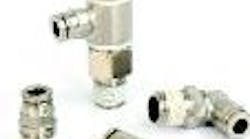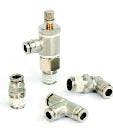Line of push-to-connect fittings provides instant connection and sealing while maintaining optimum flow. They feature nickelplated brass release rings and housings in thread sizes of 10-32 UNF to 1/2 in. NPTF and tube diameters of 1/4 and 3/8 in. Operating pressure is 265 psi, vacuum is 29 in. Hg, and temperature is -20° to 176° F.
AirCylindersDirect.com, (866) 404-5300, www.aircylindersdirect.com


